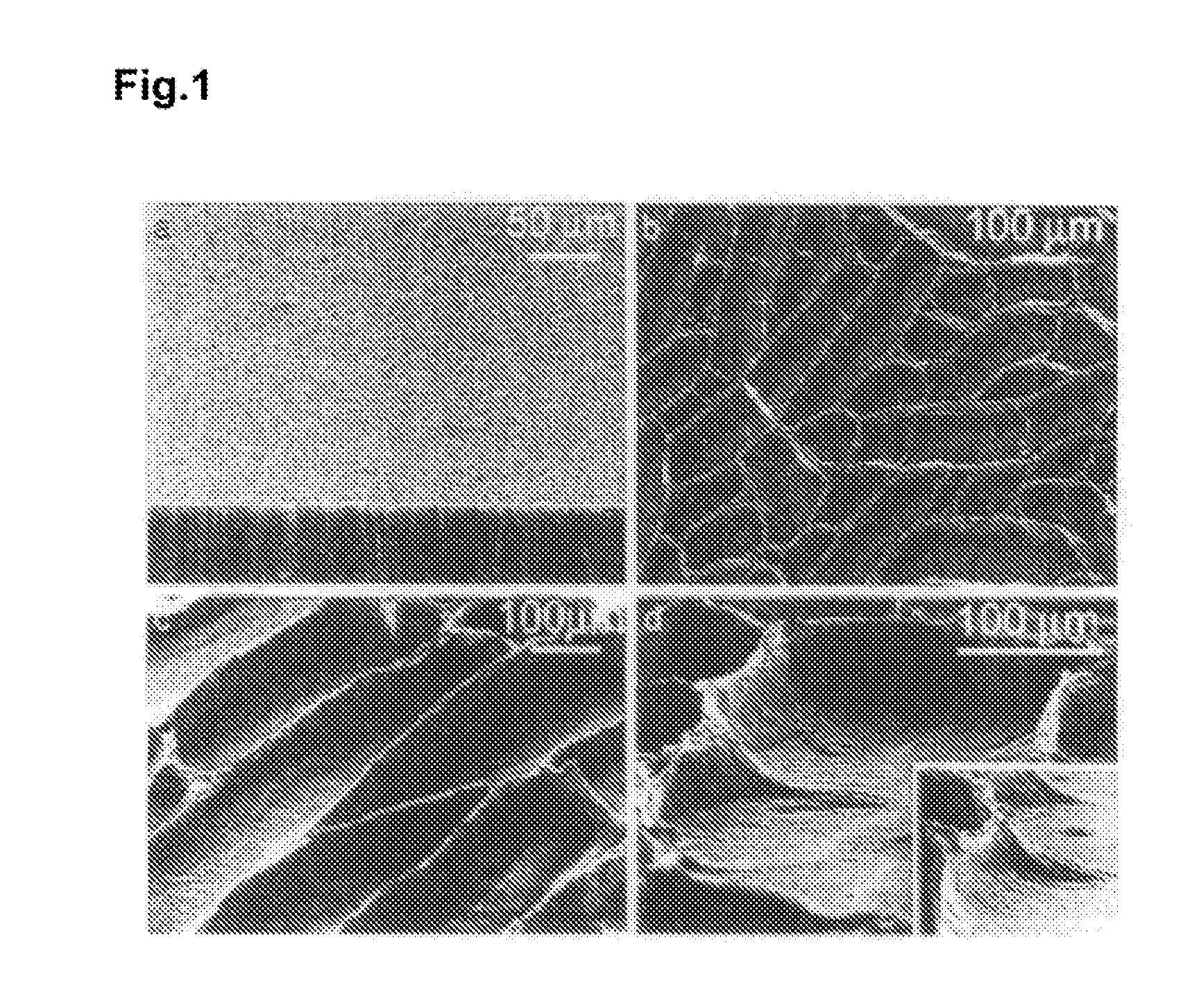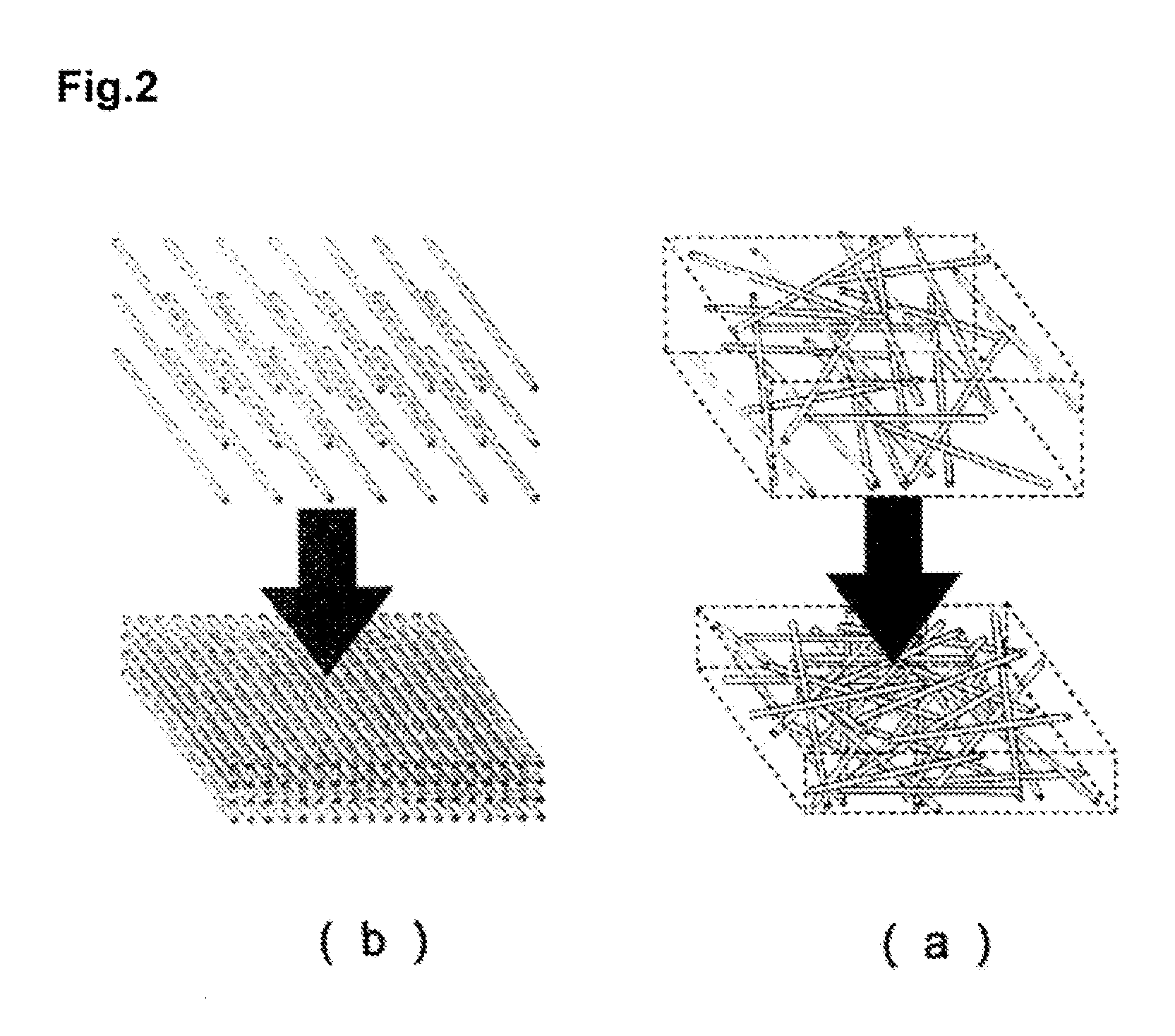Carbon nanotube film structure and method for manufacturing the same
a carbon nanotube and film structure technology, applied in the field of carbon nanotube film structure, can solve the problems of disposing a cnt, unable to apply a well-known integrated circuit production process that requires coating of resists or the like, and it is difficult to manufacture high density aligned cnt film structures, etc., to achieve the effect of facilitating design, high density cnt, and further integration
- Summary
- Abstract
- Description
- Claims
- Application Information
AI Technical Summary
Benefits of technology
Problems solved by technology
Method used
Image
Examples
example 1
DEMONSTRATION EXAMPLE 1
[0315]Result of demonstrating the controllability for the film thickness and the weight density before and after the densifying treatment in the densifying step of the invention is shown below. As the experimental conditions for this purpose, for obtaining a desired number of CNT films of a desired thickness, the width of the metal catalyst film served for the chemical vapor deposition step (thickness of the CNT film before densification) was defined as 1 μM for 2 sets, 2 μm for 1 set, 4 μm for 2 sets, and 7.5 μm for 4 sets.
[0316]The result is to be described with reference to FIG. 18. As shown in FIG. 18(a), while the CNT film having a thickness before densification (original thickness) of 7.5 μm shrank to about 0.5 μm in average after densification, CNT films having original thickness of 1, 2, 4 μm, shrank to 0.2 μm to 0.3 μm respectively after densification. This suggests that the density is different after densification depending on the original thickness....
example 2
DEMONSTRATION EXAMPLE 2
[0322]The degree of anisotropy, that is, the degree of alignment property can be recognized by measuring the resistivity of a CNT thin film by a 4 terminal method. The 4-terminal method is carried out, for example, as shown in FIG. 20, by placing a CNT thin film 5 on a measuring site in which four Au electrodes 7a to 7d each of 2 μm width are arranged each at 2 μm distance.
[0323]The resistivity was measured by the 4-terminal method in this demonstration example, as shown in FIG. 21, by providing a measuring substrate equipped with 6-sets of the measuring sites shown in FIG. 20, and providing CNT thin films each having a thickness of 306 nm, a weight density of 0.28 g / cm3, and an average diameter of 2.8 nm, and CNT thin films each having a thickness of 835 nm, a weight density of 0.19 g / cm3, and an average diameter of 2.8 nm patterned with measuring portions of the lateral size (1, 2, 5, 10 μm for parallel direction, 2.5 μm for perpendicular direction) differen...
example 3
DEMONSTRATION EXAMPLE 3
[0326]For the CNT thin film having a thickness of 450 nm, a weight density of CNT of 0.46 g / cm3, and an average diameter of CNT of 2.8 nm, alignment property was evaluated quantitatively by the Herman's orientation factor.
[0327]FIG. 23 shows an atomic force microscope (AFM) image processed so as to exhibit the degree of unevenness on the surface of a CNT thin film adhered to the planar substrate and FIG. 24 shows a planar image representing the distribution of unevenness in each direction by a frequency distribution by Fast Fourier Transformation (FFT) of the AFM image.
[0328]It has been recognized already in FIG. 23 that CNTs extend in the vertical direction and, in FIG. 24 representing the same by a frequency distribution for each of the directions, the profile for the frequency distribution forms a flat elliptic shape with the abscissa being as a major axis. This represents that CNTs are aligned in the vertical direction in FIG. 23. Then, as the ellipsis bec...
PUM
 Login to View More
Login to View More Abstract
Description
Claims
Application Information
 Login to View More
Login to View More - R&D
- Intellectual Property
- Life Sciences
- Materials
- Tech Scout
- Unparalleled Data Quality
- Higher Quality Content
- 60% Fewer Hallucinations
Browse by: Latest US Patents, China's latest patents, Technical Efficacy Thesaurus, Application Domain, Technology Topic, Popular Technical Reports.
© 2025 PatSnap. All rights reserved.Legal|Privacy policy|Modern Slavery Act Transparency Statement|Sitemap|About US| Contact US: help@patsnap.com



